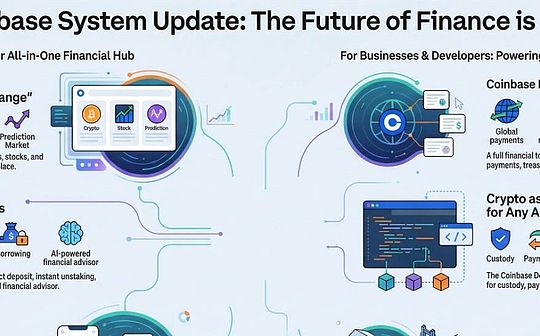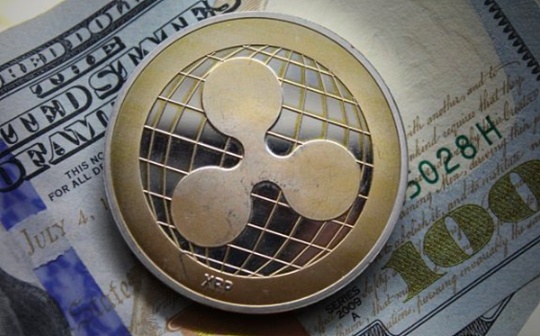
Author: Insights4vc Source: Substack Translation: Shan Ouba, Bitchain Vision World
In the past week, the price of XRP rose about 60.96%, from $ 1.46 to $ 2.35, with a market value of more than $ 130 billion.This article will briefly analyze the historical development, ecosystems behind Ripple (the company behind XRP), and the latest progress in the participation and regulatory participation in the real world assets (RWA) tokens.
Ripple was founded in 2013, formerly known as OpenCoin, and later renamed Ripple Labs.As a pioneer of blockchain technology, Ripple focuses on cross -border payment and decentralized finance (DEFI).The core of the Ripple ecosystem isXRP Ledger (XRPL)This distributed ledger was developed by David Schwartz, Jed McCaleb and Arthur Britto in 2011. It aims to provide high -efficiency, scalable and secure global payment solutions, which is in line with the vision of Ripple’s modern financial infrastructure.
The latest progress of XRPL
•Breakthrough of RWA tokenization: On November 25, 2024, Ripple announced that it cooperated with Archax, the first digital asset exchange to obtain the British FCA supervision, using XRPL to vilate ABRDN’s 3.8 billion U.S. liquidity fund.This marks the launch of the tokens of the first currency market fund on XRPL, which further consolidates its leading position in actual assets.
•Deepening of regulatory participation: On December 2, 2024, Wisdomtree joined Bitwise, 21Shares and Canary Capital to apply for the launch of the US Securities and Exchange Commission (SEC) to launch the existing XRP Exchange Trading Fund (ETF).This trend reflects the increasing attractiveness of XRP among institutional investors, and also shows the widespread adoption of token financial instruments.
XRP Status: Review of the third quarter of 2024
Ripple’s quarterly report reveals the key development of XRP and a wider -wide encrypted market:
•Clear legal status: The court ruled that XRP was not a securities, so that it was re -listed on the United States and other international exchanges.The distinction between Ripple and XRP has been widely recognized.
•Institutional interests increase: GrayScale has launched XRP trust products, and Bitwise, Canary and 21Shares have submitted XRP ETF applications.This shows that the agency’s confidence in XRP has continued to rise.
•Macroeconomic impact: 50 basis points at the Federal Reserve have caused risk assets, and the encryption market rebounded.In addition, the launch of Ethereum Ethereum has attracted $ 552.2 million in capital inflows.
•Regulatory environment: SEC appealed on some ruling of the Ripple case, but admit that XRP itself is not securities.At the same time, Japan, the UAE and Hong Kong countries and regions have adopted more friendly encryption regulatory policies, which is in sharp contrast to the United States’ law enforcement actions.
•Global expansion: Ripple has obtained regulatory approval in Dubai and promotes encrypted innovation through strategic investment and advocating activities.
As the encrypted ETF leads market growth and the US presidential election approaches, regulatory clarity and industry maturity will be the key to the future development of digital assets.
Core team member
•CEO: Brad Garlinghouse
•Co -founder and Chairman of Executive: Chris Larsen
•XRP Ledger Chief Technology Officer: David Schwartz
•XRP LEDGER co -founder: Arthur Britto
•Chief Financial Officer (CFO): Jon Bilich
•Chief Legal Officer (CLO): Stuart Alderoty
•Former co -founder: JED MCCALEB (now Stellar co -founder)
Ripple Labs, INC. (XRP) financing profile -Total financing: 294.5 million US dollars
Round of financing:
1. 1.Unveiled round
date: April 11, 2013
Financing amount: Unexpectedly
investor: Andreessen Horowitz (A16Z), LightSpeed Venture Partners, Vast Ventures
2.Seed wheel
date: May 14, 2013
Financing amount: Unexpectedly
Some investor: GV (Google Ventures), IDG Capital
3..Seed wheel
date: November 12, 2013
Financing amount: $ 3.5 million
Some investor: Core Innovation Capital, Camp One Ventures, IDG Capital, Hinge Capital
4. 4..A round of financing
date: December 3, 2014
Financing amount: $ 4 million
Some investor: Santander
5.A round of financing
date: May 19, 2015
Financing amount: $ 28 million
Some investor: IDG Capital, BolockChain Capital, Digital Currency Group (DCG), Core Innovation Capital, Rre Ventures, CME Ventures
6.Extend the A round of financing
date: October 6, 2015
Financing amount: $ 4 million
Some investor: Santander, CME Ventures, Seagate Technology
7.Series B financing
date: September 15, 2016
Financing amount: $ 55 million
Some investor: SBI Investment, Accenture, Santander, CME Ventures, Seagate Technology, Hinge Capital
8..Series C financing
date: December 20, 2019
Company valuation: $ 9.8 billion
Financing amount: 200 million US dollars
Some investor: Tetragon Financial Group Limited, SBI Investment, Bossanova Investimentos, Route 66 Venture
Token economics
XRPIt is the native asset of the XRP LEDGER (XRPL). It was founded in 2012. The total supply is fixed at 100 billion yuan, and all of them are pre -mining.
• in,80 billionAllocate to Ripple Labs,20 billionIt is allocated to a member of the founding team.
• In order to stabilize the market and manage holdings, Ripple will55 billion XRPIn the custody account, the monthly release is up to 1 billion XRP, and the release cycle is expected to be 55 months.
• Unused XRP will be lock again to extend the release time.As of December 2024, Ripple still holds a contract37.24 billion XRPStandardous.
Ripple’s stablecoin RLUSD
Ripple originally plannedDecember 4, 2024The launch of stablecoin RLUSD, but it is currently delayed due to waiting for supervision approval.Ripple is working with the New York State Financial Services Bureau (NYDFS) to meet strict regulatory requirements and maintain high -level operating standards.
Overview of RLUSD:
•The time announced the time: April 2024
•Asset support: It is fully supported by US dollar deposits, short -term US Treasury bonds and cash equivalents.
•Target: RLUSD, as an enterprise -level and compliance priority stablecoin, is designed to supplement Ripple’s cross -border payment solutions and run together with XRP.
•Market prospect: As the stable currency market is expected to increase by 2028$ 28 trillionAbove, RLUSD is considered an important contributor to this rapid expansion.
Key indicators (December 5, 2024)
>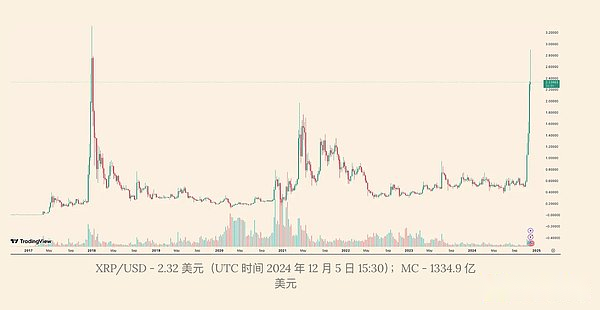
>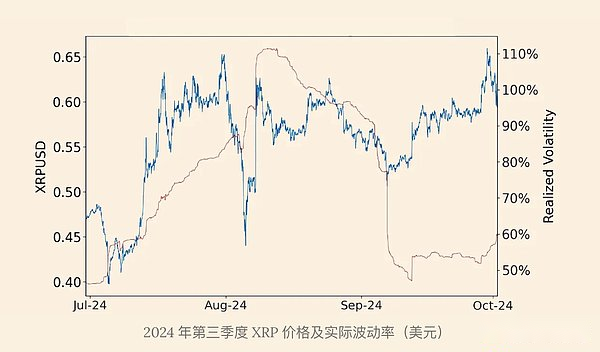
>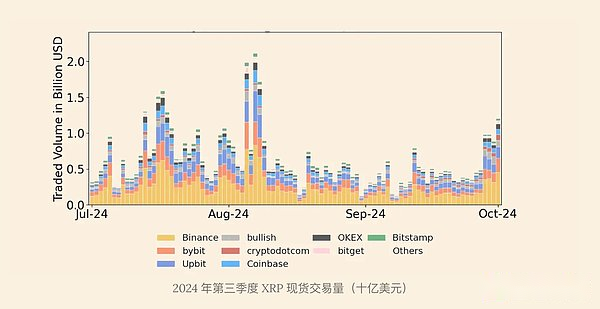
XRP ledger: detailed overview
XRPL and TraditionThe workload certificate (POW) or equity certificate (POS) blockchain is different, and a federal consensus model is adoptedThere is no need to minimate or pledge to allow the verification to reach an agreement on the status of the reconciliation.The consensus agreement aims to improve efficiency, reduce delays, and reduce computing expenses, thereby achieving the end of rapid transactions.
Verificationer network and unique node list (UNL)
The XRPL network is composed of more than 109 verifications distributed in the world.The subsets of these verifications form the sole node list (UNL), which is essential for reaching consensus.UNL consists of 31 trusted verifications, including Arrington XRP Capital, Bifrost Wallet, Ripple Labs, and XRPSCAN.Although any entity can operate the verification device and publish UNL, the default UNL is greatly affected by Ripple Labs and XRP Ledger Foundation.
Concentration problem:
The default UNL dependent of influential organization planning has triggered questioning of centralized issues.Critics believe that the choice process of trusted authenticants does not need to be permitted at all, and may damage the decentralized spirit of blockchain technology.However, supporters emphasize that users can self -modify their UNLs to allow decentralization to achieve a certain degree of decentralization based on personal trust preferences.
Consensus process
The consensus process in XRPL is carried out by iterative rotation, where the verifications are proposed and agreed to incorporate the transaction set into the next category.This process includes:
-
Proposal stage:The verified person submits a proposal transaction set.
-
Voting stage:The verifications adjust their proposal based on the proposal received from the UNL.
-
Reach consensus:Once the vast majority (usually 80%) consent, the transaction collection will be applied to the classification account.
-
Classified account verification:Verifier publishes signature verification information containing the new classified account hash value to confirm the consensus.
-
Bilateral protocol:The trust line acts as a bilateral credit agreement between the two accounts, and defines the balance and trust parameters of each token.
-
Based to tokens receiving:They ensure that any account cannot impose tokens to another account without consent, thereby maintaining the user’s control of the assets received by users.
-
Transaction control:Trust lines can achieve frozen assets, requiring authorization transfer, and setting up the “ripple -free” logo to prevent unexpected balance adjustment.
-
Have enabled: It is very suitable for interactive agencies such as city merchants to enhance liquidity.
-
Disabled: It is recommended to seek user use for preventing unexpected balancing adjustments.
-
Attract Ethereum developers and DAPP.
-
Cross -chain asset transfer is achieved through Axlar and other bridges.
-
Token to the liquidity pool.
-
You can participate in decentralized finance without external dependencies.
-
Ledger: Ensure consensus on the latest status and transaction order.
-
Decentralization: You can run without central authority to avoid single -point failure.
-
Stable: Even if the participants have changed or their behavior is improper, they can still make progress.
-
Safety first: Priority consideration, stop verifying incorrect transactions during interruption.
-
efficiency: Avoid the typical energy dense process in the workingload certificate (POW) system.
-
Current state: Account balance and object.
-
Transaction set: Transactions applied to previous classification accounts.
-
Metadata: Cryptohash and classification ledger index.
-
proposal: Vermittor submits a transaction set.
-
vote: Verifications adjustment proposal based on the input of the same peer.
-
consensus: Absolutely most agreed to apply to transactions.
-
verify: Verifier signed and issued a new classification account.
-
Verification device failure: Handle up to 20 % of the fault verification device; if the failure exceeds 20 % but it is still less than 80 %, it stops to ensure integrity.
-
Resistant witch attack: Based on the impact of trust and the effect of manual UNL selection to limit the impact of false identity.
-
Constant inspection: Refusing to violate the rules, such as unauthorized XRP creation.
-
May 5, 2015: RIPPLE was fined $ 700,000 for violating the Bank Secret Law (including operation as an unregistered currency service company (MSB) operation).Ripple agrees to implement compliance measures and enhance its agreement.
-
June 13, 2016: Ripple received Bitlicense issued by the New York State Financial Services Department, becoming the fourth company to obtain the permit.
-
September 2017: Blockchain company R3 filed a lawsuit against Ripple and requested the implementation of an agreement to purchase 5 billion XRP for $ 0.0085.Ripple refuting that as the value of XRP soared, R3 had speculative behaviors.That disputeSeptember 2018Followed on the unveiled clauses.
-
February 2020: “Financial TimesIt is reported that Ripple’s main partner Moneygram received $ 50 million from Ripple before using XRP -based liquidity tools.Ripple provides these tools for free and provides a total of $ 8.9 million in subsidies in the fourth quarter of 2019.XRP sales are considered the main driving force for Ripple’s profit.
-
December 22, 2020: The US Securities and Exchange Commission (SEC) has accused Ripple and its executives Christian Larsen and Brad GarlingHouse raised $ 1.3 billion through unregistered securities involving XRP.Ripple raised these allegations, and the court later limited the right to obtain a large number of bank records of the defendant.
-
July 2023: The U.S. District Court ruled in a milestone ruling that the XRP sold in the procedural transactions of cryptocurrency exchanges does not constitute a securities under Hawking test.However, sales and financing involving XRP can be regarded as securities.After two years of lawsuit, the judge Analisa Torres issued the ruling.
-
October 2023: SEC has revoked a lawsuit against the Ripple executive Garlinghous and Larsen, marking that the case was partially resolved.
-
June 2024: Ripple revealed that its legal defense amount to the SEC has exceeded 100 million US dollars, highlighting the financial pressure caused by long -term regulatory review.
This mechanism ensures that all participants agree with the status of the ledger and the order of transactions, without requiring resource -intensive mining activities.
Transaction speed, cost and account reserve
Transaction speed
The trading speed and capacity of different blockchain platforms are significantly different.XRP processes transactions within 3 to 5 seconds, supporting a throughput of about 1,500 transactions (TPS) per second.Solana achieved the speed of the sub -second transaction, with a maximum capacity of up to 65,000 TPS.In contrast, Bitcoin takes more than 10 minutes per transaction, processing 5 to 6 TPS, and Ethereum handles transactions at a speed of 13 to 15 TPS.
Transaction fee
XRPL’s transaction costs are extremely low, and each transaction is about 0.00001 XRP.This low cost has economic feasibility for users who frequently trades and small payment, which meets the goal of promoting high -efficiency value transfer.
Trust quota and reserve requirements
A unique aspect of XRPL is usedTrust lineToken management.To activate the new XRPL account, users must keep at least at least10 XRPEssenceIn addition, the only type of currency held in the wallet requires additional reservations2 XRPEssenceThese reserves can be used as anti -spam measures to prevent ledger expansion and prevent malicious activities.
Trust line function:
Ripple mechanism
Rippling in XRP ledger (XRPL) can promote efficient net settlement by adjusting the tokens between the interconnected trust line, thereby bypass the issuer’s direct participation.Users can control this function:
This flexibility can ensure that the network participation is customized according to user needs.
Hooks used to enhance functions
Hooks is a lightweight Webassembly (WASM) code that can achieve programming functions such as transaction automation, compliance inspection or payment modification.HOOKS is deployed on the XAHAU network (XRPL’s side chain), which can enhance programming and maintain the stability of the main network.
EVM compatible side chain
The side chain compatible with Ethereum virtual machine (EVM) aims:
It is currently in the test stage. The side chain uses XRP as GAS, positioning XRPL as a wider range of blockchain interoperability.
Native AMM Integrated
XRPL’s automatic city merchant (AMM) can directly provide decentralized tokens on the ledger and provide liquidity. Support:
This native AMM enhances the appeal of XRPL in the DEFI ecosystem.
Detailed explanation of XRP account consensus agreement
>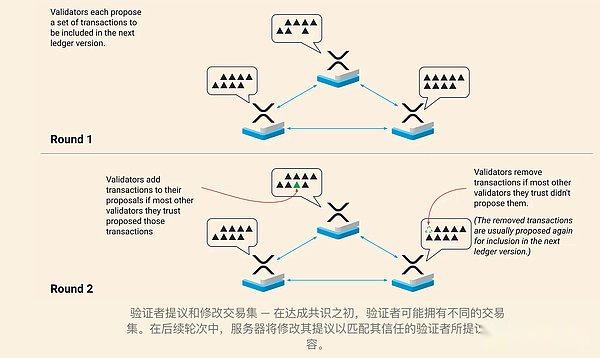
The consensus mechanism is the pillar of the decentralized payment system, which can ensure that all participants agree to the state of the ledger without concentrated control.The XRP ledger consensus agreement emphasizes efficiency, security and elasticity of fault mode.
Main feature
Prevent dual payment
To prevent dual payment, XRPL sorts the transaction in a certain way.Only one in any conflict transaction will be verified, so that no need to concentrate the dispute.
Led
Each classification account version includes:
This structure has created an unspeakable historical record, and each classification account contains a complete current state for rapid verification.
Trust -based verification
Participants form aThe only node list (UNL)Trust verifications will not act maliciously.This trust model supports the security of the system: verifiedrs will only affect those who trust them.
Consensus process includes:
Fault tolerance and safety
Adaptive cost mechanism
Verifications dynamically adjust the transaction costs and reserve requirements, and balance accessability and network protection.Key parameters include basic transaction fees, account reserves and ownership reserves. Decisions are reached through median voting.
Enhance activity: negative UNL
In order to maintain progress during the interruption,Negative unlWill temporarily exclude unavailable verifications, adjust the number of legal number of people, and re -integrate them during recovery.This function ensures continuity without damage to security.
Ripple: Supervision and legal development
Ripple is facing regulatory challenges in its entire operating history, which reflects the complexity of navigation in the legal environment that is constantly changing in blockchain and digital assets.
Key milestone:
in conclusion
The recent market value of XRP has soared to 50 billion US dollars, reflecting the re -ignition of market interests, but people still have doubts about their long -term institutional adoption and supervision challenges.The progress of Ripple (including the tokenized financial plan and ETF application) indicates that it has made progress, but also faces obstacles, especially in responding to complex laws and global frameworks.Although the SEC’s ruling clarifies the status of XRP in some cases, the uncertainty still exists, which highlights the necessity of cautious and optimistic attitude towards its continuous financial ecosystem.


